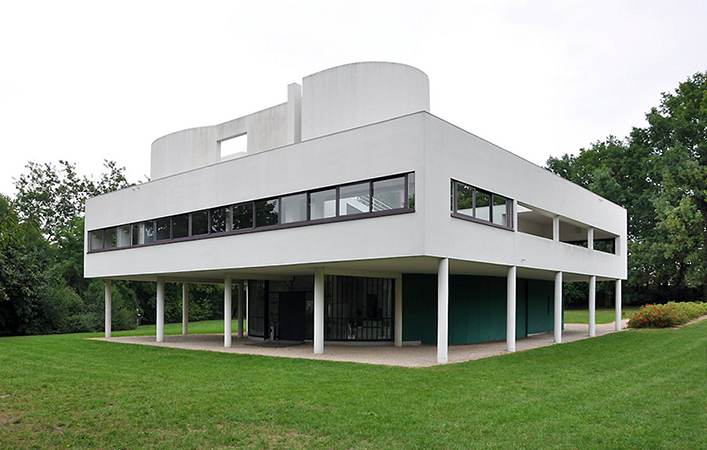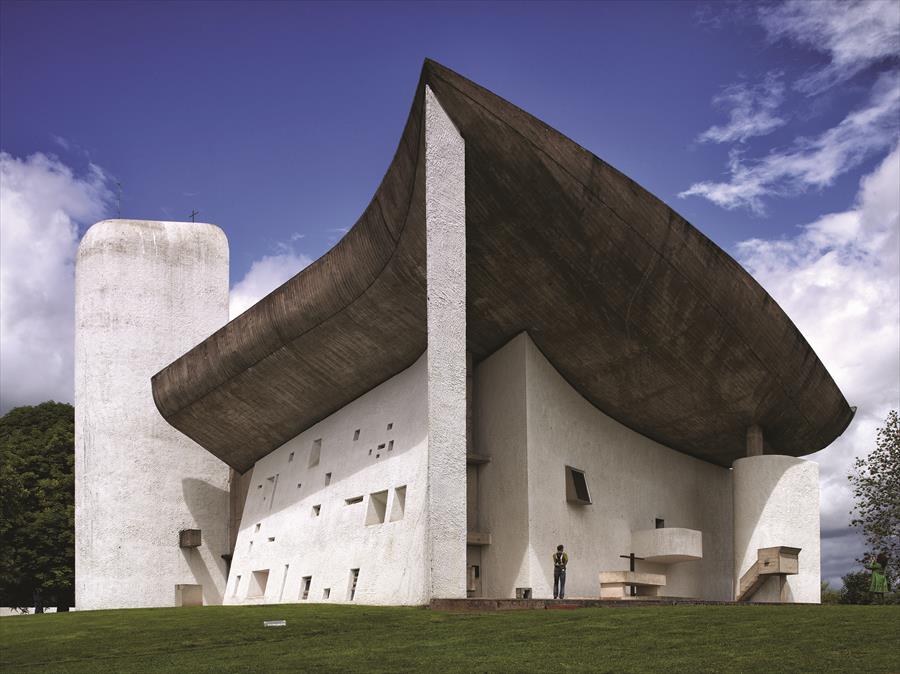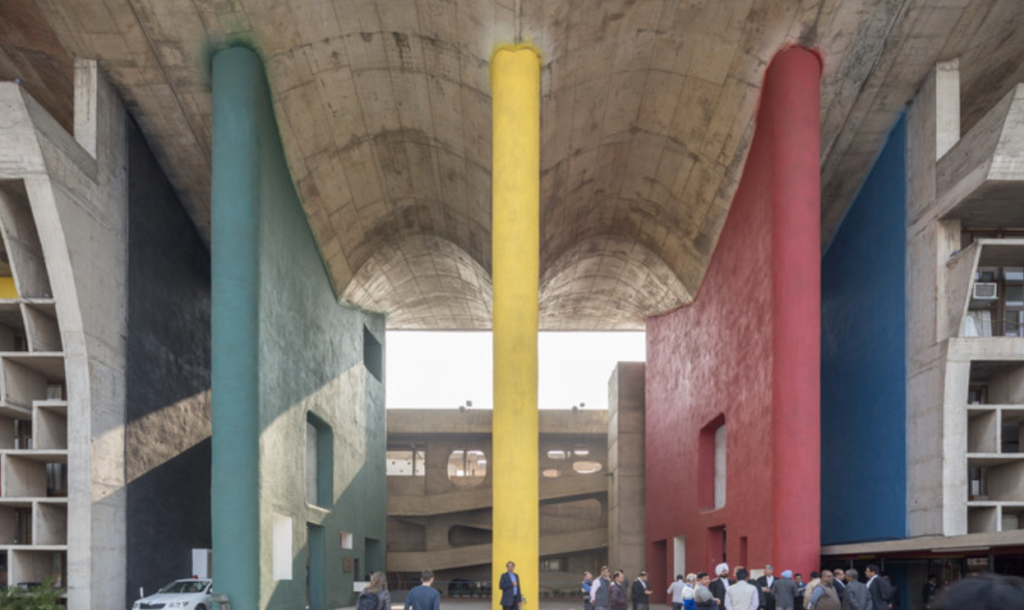Charles-Édouard Jeanneret-Gris, better known as Le Corbusier, was a Swiss-French architect, designer, painter, urban planner, and writer. He is considered one of the pioneers of modern architecture. This article will explore Le Corbusier’s life, his contributions to architecture, his influence on high-performance buildings, and how his principles continue to shape the future of sustainable architecture and urban development.
In the early 1920s, Le Corbusier developed a new architectural style that he called “The Five Points of Architecture.” These points included:
- Pilotis: Raised buildings on columns, freeing up the ground floor for open space.
- Free plan: An open floor plan with no interior walls, allowing for flexibility in the use of space.
- Long horizontal windows: Large windows that allow for plenty of natural light.
- Roof gardens: Roofs that are planted with vegetation.
- Modular coordination: A proportional system based on the human scale.
Le Corbusier’s work was influential in the development of high-performance buildings. His focus on functionality, efficiency, and sustainability has helped to create buildings that are more energy-efficient, environmentally friendly, and comfortable for occupants.
Some of Le Corbusier’s most famous works include:

Villa Savoye
(1929-1931)

Chapelle Notre Dame du Haut
(1950-1955)

Unité d’Habitation
(1947-1952)
Le Corbusier Recognized by UNESCO
On this day, in 2016, Le Corbusier work was included in the UNESCO World Heritage sites list as “Outstanding Contributions to the Modern Movement.” The seventeen architectural marvels that are part of this cross-national collective stretch across seven nations, acts as enduring symbols of a radical architectural language that completely deviated from historical conventions. These structures were erected over the span of half a century, a result of what Le Corbusier referred to as “persistent exploration”.
Le Corbusier’s Influence on High-Performance Buildings
Le Corbusier’s architectural philosophy intersects remarkably with high-performance buildings’ ethos, which aims to maximize efficiency, reduce energy consumption, and improve overall environmental impact. Here are specific instances of how Le Corbusier’s work has shaped the approach to high-performance buildings:
- Use of Natural Light: Le Corbusier’s buildings frequently featured large windows for ample natural light, reducing the need for artificial lighting and, consequently, saving energy while enhancing occupant comfort.
- Sustainable Materials: Le Corbusier was a pioneer in using durable and recyclable materials such as steel and reinforced concrete, which have since become staples in high-performance buildings, contributing to reduced environmental impact during construction.
- Modular Design: Le Corbusier’s Modular system, a proportional system based on the human scale, enhances efficiency and functionality, ensuring that high-performance buildings are comfortable for individuals of all sizes.
- Urban Planning: His urban planning concepts, which promote the separation of pedestrian and vehicular traffic and the inclusion of green spaces, are in sync with the goals of high-performance buildings and sustainable urban development.
- Standardization and Repetition: Le Corbusier’s designs often involved standardization and repetition, aiding in efficient construction and resource use—an approach that continues to influence the process of constructing high-performance buildings.
It is important to note that Le Corbusier was working in the early 20th century, when the principles of high-performance building were not as well-understood as they are today. His work was groundbreaking for its time, and it has had a lasting impact on the field of architecture.
Le Corbusier’s work did some things that contradict high-performance building. For example, his use of pilotis (raised buildings on columns) can lead to increased energy consumption, as the columns need to be heated and cooled in the same way as the rest of the building. Additionally, his use of large windows can lead to heat loss in cold climates, and his use of concrete can lead to moisture problems.
Today, architects and builders are able to design and construct high-performance buildings that avoid the drawbacks of Le Corbusier’s work. These buildings use a variety of techniques to reduce energy consumption, including insulation, energy-efficient appliances, and renewable energy sources. They also use materials that are durable and environmentally friendly.
As the principles of high-performance building continue to evolve, we can expect to see even more efficient and sustainable buildings being constructed in the future.
As we navigate the future, the principles that Le Corbusier espoused—efficiency, functionality, and sustainable urban development—are more pertinent than ever. However, the sphere of high-performance buildings also faces substantial challenges and opportunities.
A significant challenge lies in harmonizing energy efficiency with the comfort of building occupants. Although Le Corbusier’s design principles provide crucial insights, developments in technology and deeper comprehension of human behavior present new opportunities for designing buildings that are both energy-efficient and comfortable.
In our pursuit of sustainable cities, we must also ensure inclusivity. Le Corbusier’s urban planning principles serve as a foundation, but issues of accessibility and social equity also demand attention.
The future holds immense potential in integrating renewable energy technologies into building design. Just as Le Corbusier adopted new materials like steel and concrete, modern architects can incorporate advanced technologies such as solar panels, green roofs, and energy-efficient appliances into their designs.
Le Corbusier died in 1965. His work continues to be influential in the field of architecture, and his ideas about high-performance buildings are still relevant today. His groundbreaking work offers invaluable lessons. However, the onus is upon us to continue pushing the boundaries of possibility. As we grapple with climate change, population growth, and urbanization, the principles of high-performance building hold the promise of a sustainable, efficient future.
The field of high-performance buildings is constantly evolving. Recent trends include the use of renewable energy technologies, the development of more efficient building materials, and the adoption of new design standards. Architects and builders are also facing a number of challenges, such as the rising cost of construction and the need to meet increasingly stringent environmental regulations.
Future of high-performance buildings
Le Corbusier’s work has undoubtedly set significant milestones in the architecture world. His principles have been instrumental in shaping the direction of high-performance building development. But as this field is constantly evolving, it becomes imperative to take his lessons of functionality, efficiency, and sustainability and adapt them to our modern context.
Emerging technologies and increasing awareness of environmental sustainability are catalyzing exciting innovations in high-performance buildings. As we integrate solar panels, wind turbines, and develop energy-efficient materials and designs, we must not lose sight of the human-centric approach that Le Corbusier championed.
The future will require us not only to design buildings that are energy-efficient and environmentally friendly but also to address rising challenges such as the escalating costs of construction and meeting stringent environmental regulations. As we grapple with these challenges, let us also remember the importance of social equity and accessibility in our designs.
By drawing on the lessons from Le Corbusier’s work and coupling them with modern advancements, we can push the boundaries of possibility. This approach will help us create a built environment that is not only high-performing but also enhances the quality of human life and contributes positively to the environment. The legacy of Le Corbusier provides us with an inspiring foundation, but the responsibility to innovate and adapt for a sustainable, efficient future rests on our shoulders.


